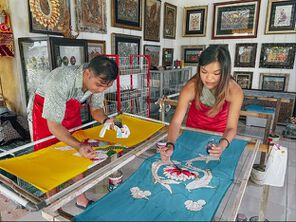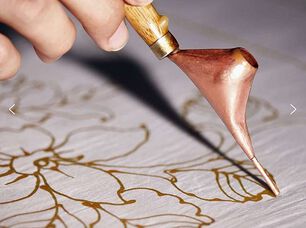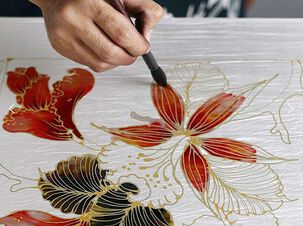Batik Paintings
To create a new page, enter a unique page name below.
If a page with that name already exists, you will be sent to a form to edit that page.
For existing pages ... see category Batik Paintings.
Fill in the form with the details of your image and save the page.
What is Batik
In simple term, Batik is an art to decorate cloth with wax as resist method. Derived from the Javanese words, amba (to write) and titik (dot), batik is an old form of art which loosely translated means to dot, while some have even translated it as wax writing or drawing with a broken line, batik is essentially a crafted fabric that needs to undergo the delicate and repeated process of waxing, dyeing and boiling. Wax is used as a mean of colour blocking in the colouring process. Every part of the fabric that remains untouched by a certain colour has to be covered with wax.
Batik techniques and process
Batik comprise of a process where a pattern or design is created with liquid wax on the cloth. This is done to protect the waxed area from being colored. So when the cloth is dipped in the color, the color does not enter the patch area which is waxed. The wax resists the colour and results into a surface which has dyed and un-dyed areas. This is how a pattern is made.
The dyes used for batik process has to be made only in vessels made of steel, plastic or enamel. This is because the properties of the material of the vessel can affect the dye. The first time when the cloth is dipped in the dye, lightest tone of the color should be used. In the old process of batik dyeing, artists were not allowed to use many colors in one go. But, with the development of advanced technology, modern techniques have been invented which makes the work of the artist easy. Now they can apply many colours using brush at one go.
Next, the cloth is again covered with wax on areas that have to retain the first colour. This process is carried out to get the darkest shade. The old Batik process involves many steps to obtain a particular shade. After the last dyeing, the fabric is placed between two layers of porous paper to dry. The wax has to be removed from the fabric onto the paper. This will give out the design that has been dyed on the fabric.
The important attribute of Batik is the cracks that appear in the design due to the wax. As the wax is frail, it cracks easy and the dye enters the waxed area. This creates a spider web design on places where wax has been applied. Normally, fabrics in pure form like pure cotton or silk is used for batik dyeing. This is because any mix in the fabric can hamper the effect of the colour on the cloth after washing.
More info:
Sarkasi Said - the "Baron of Batik"
Yogyakarta Art Batik Studio



